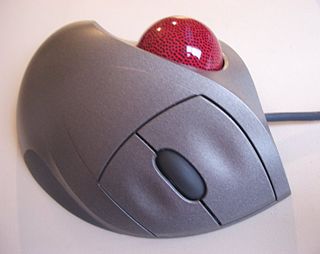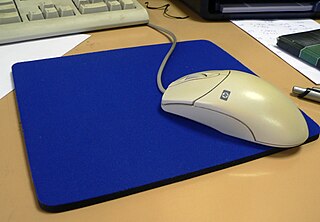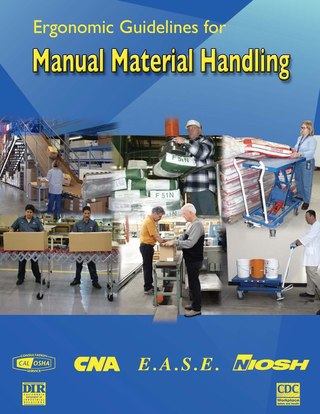A wrist rest (a.k.a.palm rest, wrist support, or palm support) [1] is a device used to support the wrists while using a computer keyboard or mouse. [2] Wrist rests have common usage in the workplace. [3]
A wrist rest (a.k.a.palm rest, wrist support, or palm support) [1] is a device used to support the wrists while using a computer keyboard or mouse. [2] Wrist rests have common usage in the workplace. [3]
Wrist rests can be made from memory foam, gel, leather, or hardwood, the most common being memory foam rests. [4] Memory foam rests retain impressions for longer, while gel rests quickly return to their original shape. [4] Gel rests provide more cooling. [4] Some computer keyboards come with a wrist rest included. [5]
Beyond the typical wrist rest designs, some companies have created variations that add extra functionality or aesthetics. For example, a laptop with a foldable wrist rest, [6] a game pad with a stylized Pokémon wrist rest, [7] or a wrist rest that also functions as a mouse. [8]

There are mixed opinions on whether wrist rests for computer keyboards are a benefit to ergonomics. [2]
The main benefit of using a wrist rest is increased comfort, especially for those using keyboards over long periods. [1] [4] Usage of a wrist rest can alleviate tension can take away pressure from the neck, shoulders and arms. [2] Using a keyboard without a wrist rest may increase the bending angle of the wrists, causing strain and tendon irritation. [1]
Prolonged contact between the wrists and the rest may cause carpal tunnel syndrome or tenosynovitis. [2] Resting the wrists on a rest while typing may prevent motion of the wrist, causing issues. [1]
To mitigate potential problems, the Occupational Safety and Health Administration (OSHA) recommends the hands to be elevated above the rest while typing. [1] While not typing, the rest should contact the hand's palm/heel, not the wrist. [1] As well, they recommend for the wrist rest's slope and height to match the front of the keyboard, and for the rest to be soft, with a depth of at least 3.8 centimetres (1.5 in). [1]
A 2004 study published in Elsevier described the literature on the efficacy of wrist rests as "limited, inconclusive, and contradictory". [3] Some studies have concluded that wrist rests reduce strain while others have concluded rests cause more strain. [3] A 2018 study looked at a sample size of 25 during prolonged typing. [9] They found wrist rests to reduce fatigue in the biceps brachii muscle but have no effect on the upper trapezius muscle. [9]

A computer mouse is a hand-held pointing device that detects two-dimensional motion relative to a surface. This motion is typically translated into the motion of the pointer on a display, which allows a smooth control of the graphical user interface of a computer.

The technology of computer keyboards includes many elements. Many different keyboard technologies have been developed for consumer demands and optimized for industrial applications. The standard full-size (100%) computer alphanumeric keyboard typically uses 101 to 105 keys; keyboards integrated in laptop computers are typically less comprehensive.

A repetitive strain injury (RSI) is an injury to part of the musculoskeletal or nervous system caused by repetitive use, vibrations, compression or long periods in a fixed position. Other common names include repetitive stress injury, repetitive stress disorders, cumulative trauma disorders (CTDs), and overuse syndrome.

A trackball is a pointing device consisting of a ball held by a socket containing sensors to detect a rotation of the ball about two axes—like an upside-down ball mouse with an exposed protruding ball. Users roll the ball to position the on-screen pointer, using their thumb, fingers, or the palm of the hand, while using the fingertips to press the buttons.

A pointing stick is a small analog stick used as a pointing device typically mounted centrally in a computer keyboard. Like other pointing devices such as mice, touchpads or trackballs, operating system software translates manipulation of the device into movements of the pointer on the computer screen. Unlike other pointing devices, it reacts to sustained force or strain rather than to gross movement, so it is called an "isometric" pointing device. IBM introduced it commercially in 1992 on its laptops under the name "TrackPoint", and patented an improved version of it in 1997. It has been used for business laptops, such as Acer's TravelMate, Dell's Latitude, HP's EliteBook and Lenovo's ThinkPad.

A mousepad or mousemat is a surface for placing and moving a computer mouse. A mousepad enhances the usability of the mouse compared to using a mouse directly on a table by providing a surface to allow it to measure movement accurately and without jitter. Some mousepads increase ergonomics by providing a padded wrist rest.
Microsoft has designed and sold a variety of ergonomic keyboards for computers. The oldest is the Microsoft Natural Keyboard, released in 1994, the company's first computer keyboard. The newest models are the Sculpt Ergonomic Keyboard (2013), the Surface Ergonomic Keyboard (2016), and the Microsoft Ergonomic Keyboard (2019).

A mat is a hard floor covering that generally is placed on a floor or other flat surface. Mats serve a range of purposes including:
PCD Maltron Ltd, trading as Maltron, is a manufacturer of ergonomic special-needs keyboards. It was founded by South African-born inventor Lillian Malt and manufacturer Stephen Hobday. Maltron specialises in making keyboards for the prevention and etiological treatment of repetitive strain injury.

An ergonomic keyboard is a computer keyboard designed with ergonomic considerations to minimize muscle strain, fatigue, and other problems.

Musculoskeletal disorders (MSDs) are injuries or pain in the human musculoskeletal system, including the joints, ligaments, muscles, nerves, tendons, and structures that support limbs, neck and back. MSDs can arise from a sudden exertion, or they can arise from making the same motions repeatedly repetitive strain, or from repeated exposure to force, vibration, or awkward posture. Injuries and pain in the musculoskeletal system caused by acute traumatic events like a car accident or fall are not considered musculoskeletal disorders. MSDs can affect many different parts of the body including upper and lower back, neck, shoulders and extremities. Examples of MSDs include carpal tunnel syndrome, epicondylitis, tendinitis, back pain, tension neck syndrome, and hand-arm vibration syndrome.

Manual handling of loads (MHL) or manual material handling (MMH) involves the use of the human body to lift, lower, carry or transfer loads. The average person is exposed to manual lifting of loads in the work place, in recreational atmospheres, and even in the home. To properly protect one from injuring themselves, it can help to understand general body mechanics.
The complications of prolonged standing are conditions that may arise after standing, walking, or running for prolonged periods. Many of the complications come from prolonged standing that is repeated several times a week. Many jobs require prolonged standing, such as "retail staff, baristas, bartenders, assembly line workers, security staff, engineers, catering staff, library assistants, hair stylists and laboratory technicians". The basic physiological change that occurs in the body during prolonged standing or sudden stand from supine position is that there will be increased pooling of blood in the legs. This decreases the venous return, and so there will be decreased cardiac output, which ultimately causes systolic blood pressure to fall (hypotension). This hypotension may lead the subject to faint or to have other symptoms of hypotension. Standing requires about 10% more energy than sitting.

A computer keyboard is a peripheral input device modeled after the typewriter keyboard which uses an arrangement of buttons or keys to act as mechanical levers or electronic switches. Replacing early punched cards and paper tape technology, interaction via teleprinter-style keyboards have been the main input method for computers since the 1970s, supplemented by the computer mouse since the 1980s.

Microsoft Tablet PC is a term coined by Microsoft for tablet computers conforming to a set of specifications announced in 2001 by Microsoft, for a pen-enabled personal computer, conforming to hardware specifications devised by Microsoft and running a licensed copy of Windows XP Tablet PC Edition operating system or a derivative thereof.
Computer-induced health problems can be an umbrella term for the various problems a computer user can develop from extended and incorrect computer use. A computer user may experience many physical health problems from using computers extensively over a prolonged period in an inefficient manner. The computer user may have poor etiquette when using peripherals, for example incorrect posture. Reportedly, excessive use of electronic screen media can have ill effects on mental health related to mood, cognition, and behavior, even to the point of hallucination.
This article is about physical therapy in carpal tunnel syndrome.

Ergonomics, also known as human factors or human factors engineering (HFE), is the application of psychological and physiological principles to the engineering and design of products, processes, and systems. Primary goals of human factors engineering are to reduce human error, increase productivity and system availability, and enhance safety, health and comfort with a specific focus on the interaction between the human and equipment.

Ergonomic hazards are physical conditions that may pose a risk of injury to the musculoskeletal system due to poor ergonomics. These hazards include awkward or static postures, high forces, repetitive motion, or short intervals between activities. The risk of injury is often magnified when multiple factors are present.